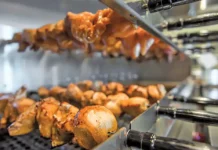
Minimum Wage Madness: 42 Different State and Local Wage Hikes Ring in the New Year. That was the lead in a white paper issued by the Employment Policies Institute, a nonprofit think tank that conducts research on employment issues such as the minimum wage and health care. It went on to make this observation: “Mind-boggling patchwork of minimum wage increases: 14 different rates in New York State, 13 different increases in California.”

For your information, I offer this thumbnail sketch of the minimum wage history in New York State. The federal minimum wage became law in 1938 and was $.25 an hour. That was 80 years ago, when many industries were exempt. That tells you that we, as a country, were still in the grips of the Great Depression. The foodservice industry was not covered until the mid-fifties. It was never intended to be the “going wage,” but rather the floor. It also, over a period of time, became a leveraging tool for organized labor, in that whenever the minimum wage was increased, those negotiating for unions demanded that the differential between those belonging to a union house and a nonunion shop be maintained.
Until recently, minimum wage rates and adjustments were determined by tripartite panels (made up of three members from the public, three members from organized labor, and three representing the public, which members were appointed by the governor). Hearings were held throughout the state. The nine-member panel would negotiate and then send their findings and conclusions to the Commissioner of Labor, who in turn would meet with the governor.
The governor would either accept it, ask the panel to make some changes, or reject it. As a result, the end product always brought an increase. However, at least the various industries were given a chance to present their case.
What has happened in New York State is that now the governor has eliminated allowing the affected industries an opportunity to present their position in an appropriate forum and explain how any proposed increases would affect both his/her businesses and employees. Now if there are any hearings about wages, they will be during the budget hearings and would have great difficulty in receiving the attention they deserve.
In the final analysis, while the governor always had the power to approve or reject a proposed minimum wage, industry participation in shaping it has been eliminated and that is an enormous game changer.
Not only is it a game changer, but it has been politicized and will become an issue every two years, similar to the early days of Social Security increases. Prior to 1973, every two years during the congressional elections, the members were inundated by their constituents. Groups picketed their offices, disrupted meetings, and so on. Finally, they gladly passed legislation using the Cost of Living Adjustment, more commonly known as COLA, to determine the increase.
For example, a number of states, including Florida and New Jersey, determine increases in their minimum wage by using this measurement. They are both considered cosmopolitan states and similar to New York. Florida’s population exceeds New York’s by a slim margin and is increasing every year by 300,000. Florida has a restaurant population in the top five. While New Jersey is smaller geographically, it is similar in many ways to New York.
Few people outside the industry and government fail to take into consideration the fact that tipped employees’ income is continuingly increasing, as menu prices are—due to operators’ costs. So does the consumers’ tipping, simply because most consumers tip on the basis of the total check.
These recent increases are steep and severe. For example, New York City will go from $11.00 to $15.00 in three years. Remember, we are talking about the floor. Then you have the differential. When the last minimum wage increase took place, Moody’s Rating was quoted as saying that maintaining the differentials would cost operators more than the increase in the minimum wage.
As I write this, it is my understanding that the governor wants to do away with all tip credits. Why would he do that? It’s like ignoring a sales person’s commission. The IRS seems to think that they have value; just ask them. Why doesn’t the governor?
Could it be that waiters and waitresses vote?
Note: During my tenure with the New York Restaurant Association, I was appointed to three minimum wage boards by three governors.























